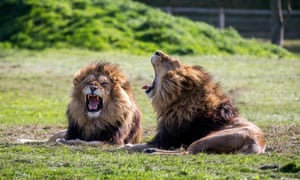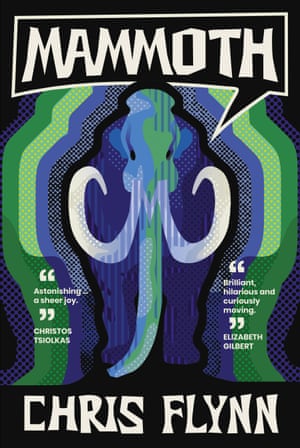Using trophy animals as power symbols didn’t start with Tiger King. According to Mammoth author Chris Flynn, the American obsession dates back to the 1700s
• Read more about Guardian Australia’s Unmissables series

Photograph: Karl Redshaw/Alamy
Barack Obama had two Portuguese water dogs, Bo and Sunny. George W Bush had scottish terriers named Barney and Miss Beazley. Bill Clinton had a cat called Socks. John F Kennedy doted on his canary, Robin.
US presidents have always had domestic animals at the White House, although the farther back we delve, the more ferocious the menagerie tends to be, particularly where Republican presidents are concerned. Calvin Coolidge owned a hippopotamus and two lions named Tax Reduction and Budget Bureau. John Quincy Adams is said to have kept an alligator in a bathroom. He supposedly found it amusing to surprise guests by sending them in there to conduct their business, presumably causing them to do so prior to removing their pantaloons.
Theodore Roosevelt took animal ownership to extremes. During his tenure, a lion, a hyena called Bill, a coyote, a black bear named Jonathan Edwards and a zebra lived at various times on the White House grounds. He also shot a reputed 11,397 creatures. Among them were lions, leopards, cheetahs, hyenas, elephants and endangered rhinoceroses.
I uncovered this curious power dynamic while researching my new book, Mammoth. It began with Thomas Jefferson, who, in an attempt to overcompensate for feelings of US inadequacy, appropriated symbols of strength from the animal kingdom to show that America was the greatest nation on earth.
Jefferson’s nemesis was the French naturalist Georges-Louis Leclerc, le Comte de Buffon. In volume five of his 1781 book Natural History, General and Particular, Buffon coined his Theory of American Degeneracy. In it, he claimed that animals in the US were weaker, smaller and fewer in number than in the rest of the world.
“There is no comparison between the size of the elephant, the rhinoceros, the hippopotamus, the camelopard [giraffe], the camel, the lion, the tiger, &c. and the tapir, the cabiai, the ant-eater, the lama, the puma, the jaguar, &c., which are the largest quadrupeds of the New World,” he proclaimed. This upset a lot of sensitive new Americans, none more so than patriotic the young Republican Jefferson.
As minister to France, Jefferson was determined to prove America’s virility to the Europeans. On one trip he packed a large panther skin with the idea of shaking it under Buffon’s nose. Later he produced a moose. The French were unimpressed. Desperate for America to appear bigger and better than everyone else – and to promote US democracy as the superior form of government – Jefferson then hired several groups of hardy pioneers to secure him a mammoth.
He had heard rumours of large bones found by explorers in various wilderness locations. He believed they belonged to a mastodon larger than anything that had ever existed in Europe, and he actively promoted the idea that such a beast might still roam the country’s west.
“The bones of the Mammoth which have been found in America, are as large as those found in the old world. It may be asked, why I insert the Mammoth, as if it still existed? I ask in return, why I should omit it, as if it did not exist? Such is the economy of nature, that no instance can be produced of her having permitted any one race of her animals to become extinct,” he wrote in 1781’s Notes on the State of Virginia.

Jefferson’s gambit paid dividends. Mammoth bones were unearthed from farmland and displayed by individuals such as the Philadelphia painter Charles Willson Peale. Mammoth fever gripped the nation. A 20lb vegetable grown in New York was proclaimed to be a mammoth radish. A Washington man ate 42 chicken eggs in 10 minutes and declared himself a mammoth eater. In Cheshire, Massachusetts, a Baptist pastor and ardent republican, John Leland, urged his congregation to produce a mammoth cheese weighing 1,235lb. It was gifted to Jefferson, who had it for lunch on New Year’s Day, 1802.
Jefferson procured and assembled his bones, spending many evenings in the White House poring over his treasures. His obsession led to accusations of negligence from colleagues and rivals alike. Little could they know that the legacy of a perceived inferiority complex would embed itself deep in the American psyche and endure for hundreds of years.
Modern presidents have, for the most part, softened their stance on trophies and the appropriation of powerful animal symbols, choosing instead to enjoy the companionship of dogs, cats and horses. Democratic presidents have tended more towards cuddly critters. In addition to his beloved canary, Kennedy had a rabbit called Zsa Zsa. Lyndon B Johnson had hamsters. Jimmy Carter had an adorable Siamese cat called Misty Malarky Ying Yang.
Donald Trump, for the record, is the first president in history to have no pets. None with four legs, at any rate.
Mammoth by Chris Flynn is out on 28 April through UQP
Read more about Guardian Australia’s Unmissable series


